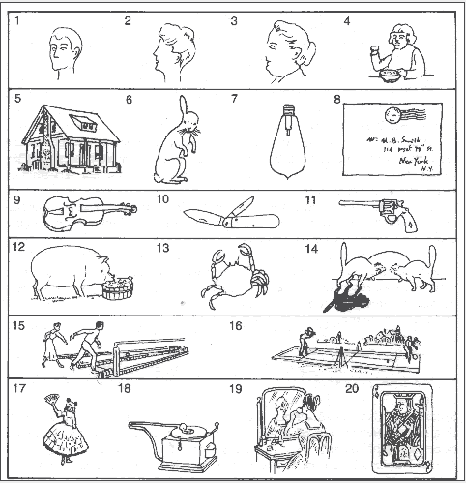The military has used aptitude tests since World War I to screen people for military service.
In 1917-1918, the Army Alpha and Army Beta tests were developed so that military commanders could have some measure of the ability of their personnel. The Army Alpha was a group-administered test that measured verbal ability, numerical ability, ability to follow directions, and knowledge of information. The Army Beta was a non-verbal counterpart to the Army Alpha. It was used to evaluate the aptitude of illiterate, unschooled, or non-English speaking draftees and volunteers.
Both the Army Alpha and Army Beta were recognized as prototypes for subsequent group-administered cognitive ability tests. Over the course World War I, some 1.5 million recruits were given tests to identify those who were capable of serving, to classify them into military jobs, and to select those who appeared to be candidates for leadership positions.
The Army General Classification Test (AGCT) and the Navy General Classification Test (NGCT) were used in World War II in place of the Army Alpha and Army Beta tests. The AGCT was described as a test of general learning ability, and was used by the Army and Marine Corps to assign recruits to military jobs. Some 12 million recruits were tested using the AGCT during World War II. The NGCT was used by the Navy to assign recruits to military jobs. Some three million sailors were tested using the NGCT during World War II.
The Army General Classification Test (AGCT) and the Navy General Classification Test (NGCT) were used in World War II in place of the Army Alpha and Army Beta tests.
The AGCT was described as a test of general learning ability, and was used by the Army and Marine Corps to assign recruits to military jobs. Some 12 million recruits were tested using the AGCT during World War II. The NGCT was used by the Navy to assign recruits to military jobs. Some three million sailors were tested using the NGCT during World War II.
Additional classification tests were developed early in World War II to supplement the AGCT and the NGCT. These included:
- Specialized aptitude tests related to the technical fields (mechanical, electrical, and later, electronics)
- Clerical and administrative tests, radio code operational tests
- Language tests and driver selection tests.
At the conclusion of World War II, the individual Services developed their own separate aptitude tests for selection, all of which included vocabulary, arithmetic, and spatial relationship items.
In 1950, the Services returned to a single test, the Armed Forces Qualification Test (AFQT).
The new AFQT was modeled after the AGCT. However, unlike the AGCT and the Army Alpha and Army Beta, the AFQT was specifically designed to be used as a screening device. Thus, the AFQT was established to (a) measure examinees’ general ability to absorb military training within a reasonable length of time, and (b) provide a uniform measure of examinees’ potential usefulness in the military. The AFQT was used by all of the Services through 1972.
Whereas the AFQT was used to identify military applicants who had a reasonable probability of success in service, other Service-specific tests were required to classify them into jobs. The Army Classification Battery, the Navy Basic Test Battery, and the Airman Qualification Examination, just to name a few, were used for classification purposes from the late 1950s to the mid 1970s.
Armed Services Vocational Aptitude Battery
The first ASVAB (Armed Services Vocational Aptitude Battery) was introduced in 1968 as a paper-and-pencil (P&P) test as part of the Student Testing Program. In 1973, the Air Force began using the ASVAB, followed by the Marine Corps in 1974. From 1973-1975, the Navy and Army used their own test batteries for selection and classification.
In 1974, the Department of Defense decided that all Services should use the P&P-ASVAB for both screening enlistees and assigning them to military occupations. Combining selection and classification testing made the testing process more efficient. It also enabled the Services to improve the matching of applicants with available job positions and allowed job guarantees for those qualified.
In 1976, the ASVAB was first used by all of the Services for selection and classification. Since 1976, a variety of content changes have been introduced to the test.
History of ASVAB Content Since Its Introduction in 1968
| Subtest | 1968 – 1975 | 1976 – 1980 | 1980-2002 | 2002 – Current (P&P) | 1990 – Current (CAT) |
|---|---|---|---|---|---|
| Word Knowledge | |||||
| Arithmetic Reasoning | |||||
| Tool Knowledge | |||||
| Space Perception | |||||
| Mechanical Comprehension | |||||
| Shop Information | |||||
| Automotive Information | |||||
| Electronics Information | |||||
| Coding Speed | |||||
| Mathematics Knowledge | |||||
| Numerical Operations | |||||
| Attention to Detail | |||||
| General Science | |||||
| General Information | |||||
| Paragraph Comprehension | |||||
| Assembling Objects |
*This table identifies the subtests that have been included on the ASVAB since its introduction in 1968. Each column represents a different version of the ASVAB. Each subtest contained in that version of the ASVAB is indicated by a checkmark in the column.
In 1979, the Department of Defense initiated a joint-Service project to develop and evaluate the feasibility of implementing a computer-adaptive version of the ASVAB (CAT-ASVAB). After 20 years of extensive research and evaluation, the CAT-ASVAB was implemented operationally in 1996-1997 at all Military Entrance Processing Stations (MEPS). It was the first large-scale adaptive test battery to be administered in a high-stakes setting. The P&P-ASVAB continues to be used at low-volume satellite locations called Military Entrance Test (MET) sites.
For almost half a century, the U.S. military has been a pioneer in the use of aptitude tests to select individuals with sufficient skills and abilities to absorb military training, adjust to military life, and become successful military members. From Army Alpha and Beta to the CAT-ASVAB, the Services have been on the cutting edge of testing technology.



